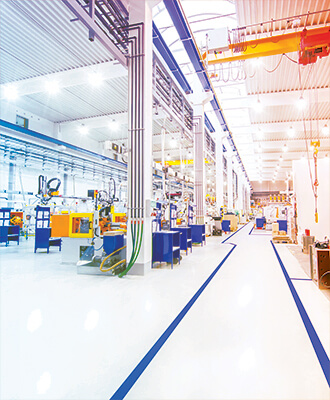Unlocking Potential
Baird's Experts Discuss Continuing Developments at the Intersection of Technology and Industry



MODERATED BY

ALLEN ROOT
LEAD ANALYST,INDUSTRIAL SECTOR STRATEGIST
PANELISTS

RICK EASTMAN
SENIOR RESEARCH ANALYST,ADVANCED INDUSTRIAL EQUIPMENT

JAYSON NOLAND
SENIOR RESEARCH ANALYST,IT SECURITY & INFRASTRUCTURE

ROB OLIVER
SENIOR RESEARCH ANALYST,SOFTWARE & SAAS

TIMOTHY WOJS
SENIOR RESEARCH ANALYST,BUILDING PRODUCT AND GENERAL INDUSTRIALS
Technology is becoming increasingly ubiquitous across the industrial space. Digital technologies, data analytics, artificial intelligence and connectivity are transforming traditional business models and bringing a new level of innovation to often slow-to-evolve industries. Today's industrial players aren't just developing competitive products and services – they are leveraging technology in transformative (and potentially disruptive) ways.
A panel of Baird's senior research analysts gathered to discuss the infusion of technology into the industrial sector. In the following discussion, the group explores the implications of this intersection for industrial companies.
ALLEN ROOT:
HOW DO THE COMPANIES IN YOUR COVERAGE UNIVERSE VIEW INDUSTRIAL FIRMS? ARE THEY SEEN AS PARTNERS OR COMPETITORS? WILL TECHNOLOGY FIRMS LOOK TO DISINTERMEDIATE INDUSTRIAL SERVICE BUSINESSES WITH THEIR OWN DATA ANALYTICS?
ROB OLIVER:
We're not yet at the point where the Internet of Things (IOT) has had a meaningful impact on any of the businesses that we cover, but it's starting to. You can definitely feel the pull. A number of years ago, John Chambers from Cisco said IOT was going to be a $19 billion market. I think we're a little closer to that now, but we're not at that point yet.
One of the overriding themes in our group is real-time visibility. That's a key driver for what we hear are increasingly the most urgent needs of industrial companies: insight into the sales pipeline, financial and accounting data, applications and more – particularly mobile applications that touch revenue. Companies also want real-time visibility into machine performance and product line functions, both to measure them and to help avoid unplanned downtime. We believe companies want that data to be able to drive performance and analytics to avoid expensive offline time.
There are a lot of companies in my group talking about that. One example is PTC, the former Parametric. They've spent more than $600 million since 2012 to amass an offering in IOT. They're doing about $100 million in revenue in that business, so they are not yet close to recouping their investment. We think they have a decent shot because they are actually in the workflow of many of the industrial companies but in a different area. They've traditionally been in the product design area, not on the factory floor. Making that pivot out to the factory floor is not going to be easy. In general, our companies are going after real-time data to determine who the "winners" are, and each company in our group has specific ways they're trying to go at it.
RICK EASTMAN:
Real-time visibility is key for traditional industrial companies, too. I think industrial technologies have evolved to a point where they're certainly driving manufacturing efficiencies, quality, production line speeds and more. However, there's additional value to be gained from the data stream now being collected and used by companies like Rockwell Automation to drive supply chain and production efficiencies. Common production challenges such as "How much inventory is on the work cell?"; "How much is on the production line?"; "Where do we need to replenish inventories?"; and "Which asset is at risk for unplanned downtime?" There are dollars to be saved addressing deficiencies as a result of the insight gained from analyzing and applying business rules to this data stream.
The data flow is tremendous – it is still a challenge to manage production processes in concert with real-time visibility. We're not there yet, but that's the expectation. Another layer here is the analytics around predictive maintenance and preventative maintenance. I think we're digging deeper down into those levels of savings. The industry is not there yet by any means, but that's where the investment is being directed.
Companies also want real-time visibility into machine performance and product line functions, both to measure them and to help avoid unplanned downtime.
JAYSON NOLAND:
For our list of software and SaaS companies, like Cisco and HP, industrial firms are viewed as partners. There is a lot of talk about smart cities. Barcelona and responsive parking come up a lot. Singapore and the use of cameras for safety do too. You hear a lot of talk about predictive analytics and how they can be used to anticipate and develop a fix in industrial applications – school buses for safety and wireless access and sensors on everything from the shop floor out through industrial applications, for example. So from my world of IT storage, infrastructure and security, the industrial world is seen as both customer and partner.
RICK EASTMAN:
I think that from a manufacturing perspective, where the automation control layer (or Operational Technology) is provided by a Rockwell Automation or Siemens, for example, companies are concerned with optimizing the production and assembly process and finding cost savings, whether it's in the supply chain or for the customers. Manufacturing companies are willing to and in many cases have partnered with information technology companies with competencies rooted in data management tasks ranging from routing, storage, security to others. What industrial companies are bringing to the table are the applications, domain expertise and real-time data collection capabilities, but it would be challenging to fund certain data management tasks on their own – so, they're more open to partnerships to achieve a robust solution.
ALLEN ROOT:
ARE THE SPECIALIZED NEEDS OF INDUSTRIAL COMPANIES DRIVING FURTHER INNOVATION IN TECHNOLOGY? OR, IS THE "LEARNING CURVE" ASSOCIATED WITH CERTAIN TECHNOLOGIES HOLDING BACK THE PACE OF ADVANCEMENT FOR INDUSTRIAL BUSINESSES?

Manufacturing companies are willing to and in many cases have partnered with information technology companies with competencies rooted in data management tasks ranging from routing, storage, security to others.
JAYSON NOLAND:
As far as the adoption of IOT and other technologies go, I would say that this is going to be a long road. We've heard about the importance of IOT for many years, but even where those solutions make a lot of sense, it just takes time for municipalities, for a shop floor, for other applications to be implemented. Unless it's green-sealed, it's really hard to build these technologies internal to the systems but it's happening. Things like smart tractors and smart industrial equipment will happen, but I think it's going to progress at a fairly predictable and moderate pace.
ROB OLIVER:
One of the things that plays into that measured pace is companies' caution about getting locked into one vendor environment. It's sort of analogous to what's happening in the cloud infrastructure space after Amazon Web Services kind of jumped out to a big lead. We've seen companies retract and say, "I don't want to be blocked into one particular vendor." To illustrate the idea a bit, imagine you work with PTC. They could do a good job for you with the IOT access they have together, but you also do business with Cisco, and you've got folks from GE Predix calling you on top of everything else.
I think Predix is an illustrative example of the pace at which the market is evolving. GE has not had success with Predix early on – it came in with a sort of catchall solution and tried to be all things to all people. It's now retracting a bit and realizing that vertical expertise is important, which is why I feel like PTC has a chance because they vetted the workflow of the industrial manufacturing and aerospace spend for many years on the CAD and PLM side. You expect a company like an Aspen Tech, which is deeply embedded in the ERP workflow of oil, gas and process industry companies that are trying to come out with a massive performance monitoring, to excel. Companies could get that chance to be that successful because of the trust the partners have, the fact that they're embedded in the workflow and their understanding the data, but in general there's some trepidation about committing wholesale to one vendor right now.

RICK EASTMAN:
It's also important to distinguish between discrete manufacturing and process-oriented industries. There's more standardization around the automation function in the process industries than in discrete markets. In discrete manufacturing, there are a number of challenges the key players have been attacking, with data aggregation out of the work cells a major hurdle. Data transfer rates have also been a challenge (which could be addressed by 5G wireless communications in the future). More recently data security has become a major concern, whereas previously an asset's lack of connectivity provided the ultimate firewall. So, while there are some real challenges they are all being addressed, if you will, and that's where this area of vertical expertise and domain expertise has become very important.
How do you get the data? How do you aggregate the data? How do you move it? How do you analyze it for very fragmented manufacturing operations? It's a little different on the discrete manufacturing side versus the process side.
ALLEN ROOT:
HOW DO YOU THINK INDUSTRIAL COMPANIES WILL MONETIZE THIS INCREDIBLE AMOUNT OF DATA THAT WILL EVENTUALLY COME OFF SHOP FLOORS?
More recently data security has become a major concern, whereas previously an asset's lack of connectivity provided the ultimate firewall.

ROB OLIVER:
There's a couple of ways we see that evolving. In ways, it's happening already. We've seen the large infrastructure of the service players. I'm thinking of Amazon Web Services, Microsoft, Azure and Google Cloud platform. They've already been engaging in what we might call machine learning as a service, which is essentially offering their machine learning expertise to anybody with their processing power. The days where you needed your own servers, your own processing power, are gone. You can just rent that from them. That's a big innovation. So, monetization is less about charging for data and more about optimizing processes around that data to save money. We also believe the question of data rights will emerge and will be a major topic going forward. Companies want to be sure the data they have is theirs.
JAYSON NOLAND:
There's a lot of talk in the building security space about the "winner" being the company or companies with the most data. It's a hot topic and I wouldn't say it interferes with the world of industrial, but it's important to note the data is used to power the solutions these companies are selling as a subscription. Those companies wouldn't sell the data, but they would collect it and look to mine it for predictive analysis, finding breaches and those sorts of things on the security side.
ROB OLIVER:
In many ways, the recurring revenue stream of a subscription is the holy grail for many companies. In the past, you'd buy a product, open the box and fill out a little card to get the warranty. That was a way for a company to track customers. Companies still want a way to have an ongoing relationship with their customers. In the software world, Salesforce is probably the greatest example of this. They converted a business that was on-premise sales and managing the sales pipeline into an ongoing customer success relationship business.

Companies increasingly see value in developing these kinds of relationships and subscriptions, too, because upfront cost is lower, you can work it through your operating expense line as opposed to your capital expense line and you get ongoing iterative value out of the subscription. I think it's a win-win. It's just a question of who is going to have the power with their customers to be able to do that as a pivot from a more traditional business model. On the industrial side, my general comment would be companies with deep relationships with the building community are probably well-positioned to move toward this kind of model because they have superior technology and the great relationships. We think these models are very attractive.
RICK EASTMAN:
We're seeing some movement in traditional industrial companies, but it's more around mobile (vs. fixed) assets. The shop floor data stream is incredibly proprietary. Companies are reluctant to share their own shop floor information publicly, but they will use it on a global level in their own facilities to drive efficiencies and savings. However, there are asset monitoring service models that are early efforts to monetize. Now if you move toward mobile assets – say, where companies like Trimble or Zebra have strong mobile portfolios – I think the SaaS model starts to emerge around sharing data, a customer's ability to share data, data might be stored in the cloud, or asset or device management.
In the case of Zebra's business model, the focus is on selling asset management software in the subscription format for remotely monitoring devices for uptime and downloading upgraded software. It's more about keeping assets utilized for a greater period of time, rather than capitalizing on a customer's data. I think there are opportunities and efforts to do that, but again those efforts are kind of in their early stages because in many cases the scale is not there and the technology's not in the market yet. I think the bigger opportunity is around asset or device management when it comes to driving some sort of recurring subscription management.
This is the 'last mile' part of the business that can be lower margin, and if you don't make those partners more productive, companies can lose share.
TIM WOJS:
We've seen similar themes play out in areas like the mobile operations, lighting or helping installation and dealer customers be more productive. This is the "last mile" part of the business that can be lower margin, and if you don't make those partners more productive, companies can lose share. Some HVAC companies use mobile and predictive analytics to better utilize fleets and engineering guides.
Take Lennox, for example. They sell directly to dealers, and it costs money for those dealers to drive around calling on customers all day. If something's wrong with an HVAC unit at a residence, dealers can tap into analytics from the unit to show up with the correct part, fix the unit and spend anywhere from 50-75% less time at that customer. That creates a sort of virtuous circle for Lennox. They're manufacturing units with these capabilities and then wrapping it to the dealer to provide this service. The dealer gets more productivity and is thus better able to service the end customer. They're able to improve their business over time. It's kind of a win-win for everybody and it makes the relationship tighter. The overarching impact is that when Lennox goes to raise prices, they're able to do it with their dealers because there are other things they're doing for their customers to be able to improve their bottom line.
ALLEN ROOT:
ARE THERE ANY TECHNOLOGIES IN THE PIPELINE THAT HAVE THE POTENTIAL TO BE TRULY DISRUPTIVE TO THE INDUSTRIAL MARKET?
JAYSON NOLAND:
I think artificial intelligence (AI) and automation are real trends and going to become even more real with time. They could absolutely eliminate repetitive tasks as well as enhance a human's ability in any number of processes. It's pretty remarkable what people are thinking about regarding uses of AI. And while quantum computing (QC) isn't really here yet, that discussion trends a little more extreme because could be used to unencrypt data that is currently encrypted in the future.

RICK EASTMAN:
I would echo the comments on the potential impact of AI. You're seeing more and more of it. It's even present in the early stages of the robotics market – certainly with co-bots. Adding incremental intelligence to the robotics market would be significant. Right now, if three scenarios are presented to a robot, there is the real chance it may freeze (with indecision). With additional AI, robots would be able to at least sift through three scenarios in real time and arrive at a decision. That would be a major development.
I would also underscore the speed of networks. I go back to the shop floor – to do anything in a deterministic way or make real-time decisions, the networks aren't there yet. In some cases the processing power is not there yet in the devices. The speed of networks is an issue and needs to continue to evolve.
TIM WOJS:
When you think about buildings and the products that go in the buildings, low-energy Bluetooth has had a big impact on adoption because it really helps eliminate the need for a lot of hard wiring. A good example is Allegion (ALLE). Hardwiring an interior door for wireless access is about $3,000 an opening. Allegion incorporates lower-energy Bluetooth and this can cut the installation cost by up to two-thirds. The connectivity through low-energy Bluetooth, at least from our perspective, is probably the most immediate benefit in terms of adoption.
ALLEN ROOT:
TO THAT POINT, ARE THERE COMPANIES THAT ARE MORE ADEPT AT CAPITALIZING ON OPPORTUNITIES THAT ARE NEW AND POTENTIALLY GAME-CHANGING?
The business case for more intelligent assets is being made to capitalize on connectivity and the ability to move data.

TIM WOJS:
There are varying cases. Some companies are better than others at pursuing those type of opportunities and it probably is going to be based on your competitive positioning and how focused you are. A company like Allegion, which has a really good core business and a strong market positioning and margin structure, we believe they have more of an ability to spend on newer technology development. Lennox, which is very focused on residential HVAC, owns their own distribution network and has more leeway and focus to make those investments, versus selling through a third-party intermediary. Acuity has used its industry leadership position to focus on developing next-generation, connected lighting systems – essentially, making a lighting fixture more of a "node" in a network, collecting consumer and employee data and offering building owners the ability to use this data to help improve their operations – from things like better deployment of employee resources, to improving merchandising, to helping customers find a product on a merchant's website on the physical store shelf.
Companies that are more focused, have better market positioning and simply better markets in general have had the benefit of making these investments ahead of time.
In a way, it's a matter of collecting the data, having the analytics to put around the data and illustrating the business case for upgrading the shop floor.
ALLEN ROOT:
MANY INDUSTRIAL COMPANIES BUY SOFTWARE ASSETS – WHAT ARE THE IMPLICATIONS FOR VALUATION WHEN A COMPANY PAYS A HIGH REVENUE MULTIPLE TO ACQUIRE A BUSINESS?
RICK EASTMAN:
There is a movement toward these kinds of deals. If you're a hardware company, you need to make your hardware smarter. A lot of the effort on the software side is to do exactly that. A benefit is a higher gross margin but the business case on the shop floor is still being proven. That's probably one of the biggest hurdles. In a way, it's a matter of collecting the data, having the analytics to put around the data and illustrating the business case for upgrading the shop floor. To fully enable the capabilities may require accelerating the replacement cycle for existing manufacturing assets and that may take time to demonstrate the ROI.
Given the current market for capital goods spend and the slow but progressive growth we're seeing, capital spending budgets haven't ratcheted up and they're not likely to. But I do think the business case for more intelligent assets is being made to capitalize on connectivity and the ability to move data. So I think there's a little bit of a race at this point to add application-specific software onto the shop floor that can distinguish your expertise in these verticals.
Everybody's talking about making connectivity, making their hardware assets smarter and trying to be experts in their verticals. I think it's viewed positively. Yes, it costs more but you're seeing the benefit in the gross margin. It's also elevating the entry barriers into their specific verticals. Quite frankly, it is making the business' traditional "manufacturing business" stickier. There's a subscription element to it, or at least a software element to it, and also less capital intensity. All positive things.







